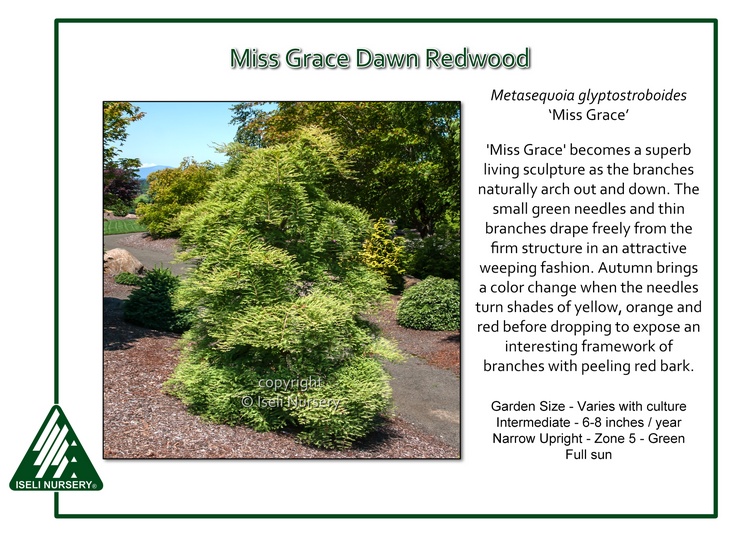
This is a selected variety of a species not originally from North America. Consider applying a thick mulch around the root zone in winter to protect it in exposed locations or colder microclimates. It is somewhat tolerant of urban pollution. It is not particular as to soil type or pH. It is quite adaptable, prefering to grow in average to wet conditions, and will even tolerate some standing water.
#Metasequoia glyptostroboides miss grace full
This shrub should only be grown in full sunlight. It grows at a fast rate, and under ideal conditions can be expected to live for 50 years or more. It has a low canopy with a typical clearance of 1 foot from the ground, and is suitable for planting under power lines. Miss Grace Dawn Redwood will grow to be about 10 feet tall at maturity, with a spread of 3 feet. They are very tolerant of even WET soils (and I believe and also deal with periodic standing water).

I just lost three containerize ones back in June because I missed watering it for a couple of days.

Miss Grace Dawn Redwood is recommended for the following landscape applications Metasequoia is medium tolerant of drought (once established IN THE GROUND). Unlike the species, Miss Grace offers a unique weeping habit and a. It has no significant negative characteristics. An fine form of dawn redwood that will change the way we think about this massive tree. Pritaikymas eldinuose: alpinariumuose, prie vandens telkini, kap apeldinimui, ir t.t. Deer don't particularly care for this plant and will usually leave it alone in favor of tastier treats. Vertinga,grai svyrania laja tikroji metasekvoja. This is a relatively low maintenance shrub, and is best pruned in late winter once the threat of extreme cold has passed. It lends an extremely fine and delicate texture to the landscape composition which can make it a great accent feature on this basis alone. Miss Grace Dawn Redwood is an open multi-stemmed deciduous shrub with a rounded form and gracefully weeping branches. The peeling antique red bark adds an interesting dimension to the landscape. The ferny bipinnately compound leaves turn an outstanding orange in the fall. Miss Grace Dawn Redwood is primarily valued in the landscape or garden for its highly ornamental weeping form. Well, it can be but I left these few plants on their stakes, and they turned out to be neat weeping trees.A small deciduous conifer with gracefully weeping branches and airy green foliage that changes to an intense orange in the fall variety can reach 10 feet tall and 3 feet wide if staked prefers sun and moist soils Unlike the species, Miss Grace offers a unique weeping habit. No, No!, I thought, for it was supposed to be grown as a ground-cover. An exciting form of dawn redwood that will change the way we think about this massive tree. The original grafts were staked up by the crew when my back was turned. "Metasequoia glyptostroboides 'Miss Grace', an elegant weeping form of "Dawn Redwood," was discovered as a prostrate witch's broom. Here is a quote from Talon Buchholz regarding the original production. It was originally thought to be a prostrate witch's broom. The plant originated somewhere in New York and was introduced to the nursery trade by Buchholz & Buchholz Nursery, Gaston, Oregon. 'Miss Grace' is a name for the selection's graceful habit. Annual rate of growth in most areas in 2 to 4 inches (5 - 10 cm), but will only grow as tall as it is staked. Produces a narrow small tree excellent as an accent or specimen.

Metasequoia glyptostroboides 'Miss Grace' / Miss Grace Dawn redwood Metasequoia glyptostroboides 'Miss Grace' is an unusual form of the Dawn redwood with strongly pendulous branches enhanced by soft, feathery, small bright green, deciduous foliage which turns orange-brown in fall. Additions to the International Conifer Register.


 0 kommentar(er)
0 kommentar(er)
